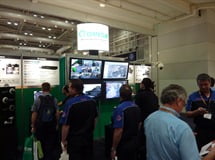SOMETHING that struck me in particular was that new product and technology in the security industry has a tidal flow to it. I felt we saw a greater number of completely new products last year yet this year I saw those products polished and enhanced. It seems to take the best part of 12 months for a product to get traction in the market. Given the complexity of many new releases, perhaps this is no great surprise. The central elements at Security 2010 were the further improvement of top end management solutions from company’s like Dallmeier, DVTel, Genetec, Milestone and Inner Range with its Insight product. Worth noting was the fact these companies are working harder to bring access control together with video surveillance – discounting Insight which always had a strong access control capability. To me the nature of current development suggests the management solutions of the future will integrate with virtually any conceivable input. Noticeably absent from the show this year were alarm products. Sure there were some high end products from Takex, Bosch and CSD, but the huge display walls of PIRs and panels were nowhere to be seen. Ness Corp, one of the local industry’s premier alarm manufacturers, was showing its new Navigator Touch Screen which fronts its panel range but no alarm gear. Talking to wholesalers you get the feeling that while the alarm side of the industry is holding its ground in unit sales, the focus of marketers has turned to CCTV to such an extent that alarms is in danger of becoming a separate business. As part of this trend I thought there were fewer groups of dusty installers wandering the floor than there used to be. Whether this represents a seismic shift in the makeup of our industry remains to be seen but I think the emphasis some of the electronic security industry’s leading companies are now placing on training is the key to drawing our young techs through and affording them the education and opportunities they need. There is greater importance being placed on technical training by associations like ASIAL, which is supporting dedicated individuals and groups with an education focus. These initiatives need to be supported and encouraged with vigour. Something else that was in short supply at Security 2010 was analogue cameras. We know they remain upwards of 75 per cent of sales but there were not many of them to be seen on stands at the show. What we did see was the pinnacle of analogue technology from makers like Panasonic, Bosch and Sony. The leading manufacturer of IP camera technology is Axis Communications – I’m going to base that opinion on the number of times we see this product in the field, as well as the relentless output of its R&D team. Other IP brands growing quickly in stature include DVTel, Arecont, Avigilon, Dallmeier, Sony and Panasonic with SmartHD. Mobotix is gaining traction too, with many installers using its very capable high resolution cameras as part of their networked applications – especially outside. Perhaps the noise in the IP camera market is based on the vagary of performance specifications which remain highly subjective. As I keep pointing out, this confusion continues to play into the hands of Axis and its range-wide adherence to SMPTE HD. Committing itself to meeting an independent performance specification was a good idea. Something else that occurred to me at Security 2010 was that networked infrastructure is a substrate, not the ultimate destination of electronic security technology. Regardless of how we build and drive our systems, the central needs of reliable sensing, secure remote reporting and quality video surveillance have not changed one bit.
18.4
C
Sydney
18
C
Canberra
25
C
Darwin
14
C
Hobart
17.7
C
Perth
19.7
C
Brisbane
13.7
C
Auckland
23.8
C
Melbourne










